Filipino fruits are one of many tropical fruit groups you need to try. Many delicious fruits can grow bountifully throughout the Philippines, mainly thanks to the tropical climate.
On the one hand, some fruits are available in every Filipino family’s backyard, in supermarkets, and even exported to many countries around the world. On the other hand, some might be hard to find and only available in certain regions.
However, they all have similar characteristics: refreshing, delicious, and healthy. They are not only good when served alone but also have excellent compatibility with delightful Filipino delicacies.
Please sit tight and pay the utmost attention! I will show you many surprises ahead with the long list right now!
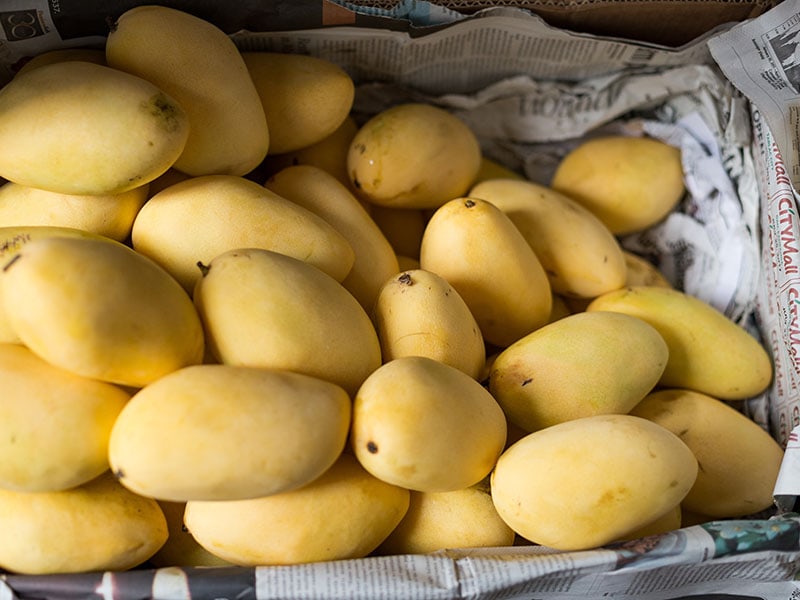
11 Green Fruits From The Philippines Can’t Wait To Be In Your Favorite List
In the first section, I will show you some green fruits from the tropical country, the Philippines. There will be some unique fruits you might never know of before and some you have eaten multiple times.
1. Sugar Apple
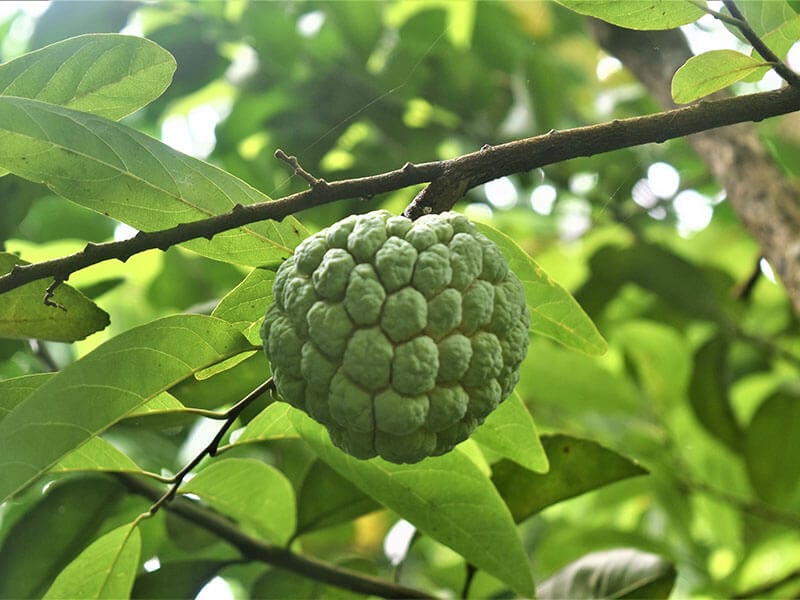
If you’re having custard textured fruit cravings, try sugar apple!
Sugar apple has multiple names that you have probably heard of, like sweet sop or custard apple. It is a native fruit in the Americas and West Indies and was introduced in the Philippines by the Spanish.
The sugar apple tree usually grows up to 3-6m (10-20 ft). The fruit size is about 6-10 cm in length and 5-10 cm in width. Typically, the sugar apple has green skin, but depending on variants or maturity stage, the fruit may have a pinkish-purple color.
The skin looks like many small pumps gathering together, creating a thick cover surrounding the white flesh. Each fruit contains 20-40 glossy inedible seeds. Usually, sugar apples deliver a custard-like, grainy texture and distinctive sweetness.
Nutrients: Vitamin C, B6, fiber.
Season: September to December.
How to eat: Use your hand to peel the skin, eat the flesh, and spit out the seeds.
2. Calamansi
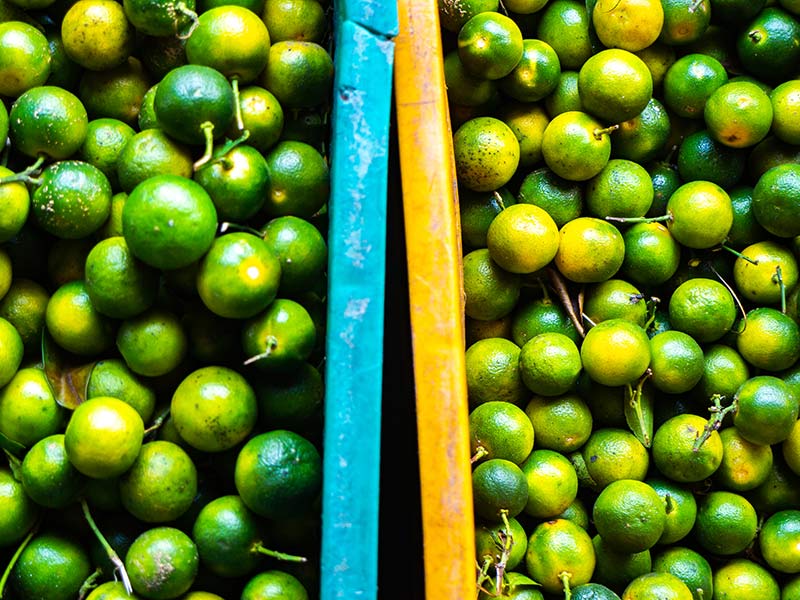
Here I will introduce one of the most popular fruits from the Philippines: calamansi. Besides that name, some locals will call it by other terms, such as Philippine lime, calamondin, or Philippine lemon.
This fruit originated in the Philippines, and it’s considered a vital element in Filipino cuisine. A squeeze of this fruit can make hundreds of different foods and drinks more delicious and viral.
The calamansi tree belongs to a shrub varying from 3-6m (9.8-19.7 ft). Its fruit is small and green. Sometimes, you might see other variations with green stripes on a yellow base.
Inside, there is a thin pith covering the juicy orange flesh. Each fruit will include from 8 to 12 seeds. It has a distinctive sour taste with a citrus aroma. Besides, this fruit indeed offers you a high source of vitamin C.
In the Philippines, people mainly use calamansi juice in food, marinating, dipping sauce, and beverages. Many dishes feature this fruit, namely Pancit (noodle dish) or Lugaw (Filipino porridge).
Nutrients: Vitamin C, A, iron, potassium, calcium, etc.
Season: mid-August to October.
How to eat: The fruit is commonly consumed as calamansi juice, one of the popular Filipino beverages in the hot summer. Besides, people use it to make food, like Sinigang (seafood broth) or Kinilaw (raw seafood in calamansi juice).
3. Coconut

Coconut, or “the tree of life”, is one of the major crops and exports in the Philippines. This fruit belongs to Arecaceae, the palm tree family, the only existing type of Cocos.
You might mistake coconut with some kind of nut because of its name. But actually, it’s a drupe. Like other drupe fruits, coconut has three layers: endocarp, mesocarp, and exocarp.
The coconut tree usually grows up to 25m and produces an average of under 30 fruits annually. However, in other circumstances, some can bear up to 75 fruits.
There are many coconut variants in the country, including Maypan coconut, King coconut, and Macapuno (coconut sport). The last one is a delicacy, a type of especially soft and nutritious coconut with little water. Its name literally means “characterized by being full”.
The nutty and sweet flavor of coconut makes it a vital element in making desserts. Some popular Filipino sweet treats that use this fruit are Halo-Halo (shaved ice dessert), Pastillas (milk-based confections), or Ube Halaya (boiled and crushed purple yam).
Nutrients: Protein, fiber, copper, minerals, etc.
Season: All-year round.
How to eat: Use a knife to cut the coconut in half, or just need to discard the top of the fruit if you want to drink coconut water. Then, use a spoon to enjoy the flesh.
4. Guyabano (Soursop)

The fruit has Arona muricata as its scientific name. Guyabano or soursop is an evergreen tree from the Americas and the Caribbean. It’s also prevalent throughout the Philippines and other countries in Southeast Asia.
You can find guyabano mainly in the Western Visayas and Central Luzon. Also, this fruit can be recognized by different names, including graviola or guanabana.
Guyabano has a distorted elliptical-like shape with thorny green skin. The fruit often weighs up between 4 and 4.5 kilograms; sometimes, its height can grow up to 30cm.
The white flesh has a firm and fibrous texture covering many black glossy seeds. Guyabano is sweet and tangy, which you can apply to make candies or ice cream. Some also describe the floral taste as a fabulous combination of strawberry and pineapple.
Nutrients: Protein, fiber, vitamin C, B1, B2, potassium, magnesium, etc.
Season: August to November.
How to eat: You remove the shell with a sharp knife, then enjoy the flesh inside without seeds. Sometimes, you can make ice cream and smoothies from the fruit.
5. Pomelo

Similar to grapefruit, pomelo also comes from the Rutaceae family. Besides, Mindanao has a bountiful source of pomelo, the second largest in the Philippines.
The tree usually has a height of 5-15m, bearing fruit in the summer. Pomelo fruit is in the form of pear fruit but with a larger size, around 15-25 centimeters in width and 1-2 kilograms in weight.
Pomelo is characterized by a thick shell and thick, soft pith. Similar to grapefruit, pomelo’s flesh is a gathering of 11-18 segments with the color varying from pale yellow to reddish-yellow.
Depending on each pomelo variant, the seed number will fluctuate from zero to many. Regarding flavor, pomelo tastes almost the same as grapefruit but sweeter with a tinge of bitterness.
Nutrients: Vitamin C, energy, and fiber.
Season: April to June.
How to eat: You can use a knife to remove the skin, then use your hand to separate each segment. Besides, Filipinos often apply the fruit to make a pink drink.
6. Jackfruit

Like many countries in Southeast Asia, jackfruit is also a dominant fruit in the Philippines. In Filipino cuisine, this staple fruit contributes to many delicious dishes.
A jackfruit tree can grow up to 15-20 meters. The fruit is relatively big: 10-25 kilograms in weight. The jackfruit shell is a spiky surface with green color, though it can sometimes turn greenish-brown or brown.
Underneath that rough skin are a bunch of yellow bulbs. Their texture is firm and crunchy when young. On the other hand, the flesh of mature ones will be softer and more similar to durian in some cases.
One jackfruit will have around 100-500 seeds depending on the size and variants. Besides, the brown seeds can also be edible with the standard cooking method: boiling.
Nutrients: Vitamin A, C, fiber, protein, magnesium.
Season: March to May.
How to eat: Use a knife to cut it in half and then eat the yellow pods. Jackfruit is used in Halo-Halo (mixed dessert) in the Philippines.
Let’s see how locals enjoy jackfruit in the Philippines.
7. Kamias (Bilimbi)

Here I introduce you to a fruit slightly similar to starfruit: kamias. Although the fruit originally comes from Indonesia and Malaysia, it’s a famous sight in the backyard of almost every Filipino household.
You might also know kamias with other names, such as bilimbi, tree sorrel, and cucumber tree. Kamias trees often reach 15 meters in height and produce many clusters of fruits. Those fruits also play an essential role in Filipino traditional foods and drinks.
They have a waxy skin fluctuating from green to yellowish-green in color as they ripen. Kamias fruit has a roundish-oblong shape. Kamias delivers a unique sour taste that is highly recommended to enjoy.
Besides the fruit, locals also utilize the leaves to cure skin problems or rheumatism. People also use kamias leaves to foster women’s health after giving birth. The flower is also great for treating cold, cough, and fungal infections.
Nutrients: Vitamin B, C, calcium, phosphorus, fiber, and iron.
Season: Available throughout the year.
How to eat: You can wash the fruit and consume it raw. Regarding Filipino delicacies, kamias appear in Sinigang (sour soup) and Pinangat (fish in sour broth).
8. Breadnut
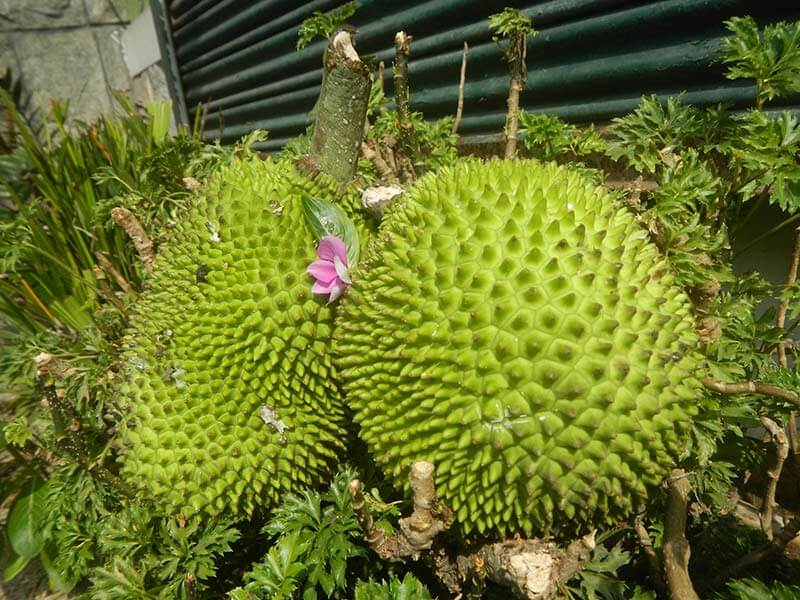
Breadnut, also called seeded breadfruit, is an edible fruit that has a home in the Philippines. It belongs to the Moraceae plant family with the botanical name Artocarpus altilis.
Each fruit weighs up to 800 grams on average, with 20 centimeters in length and 8-15 centimeters in width. When the fruit is unripe, its spiky skin remains green with fibrous flesh containing around 50 soft seeds.
On the other hand, the skin of a mature breadnut is greenish-brown or brown. The inner flesh will turn out to be light yellow with a softer consistency. The brown seeds also become harder, which are edible when roasted.
Importantly, breadnut fruit should be cooked before serving. In the Philippines, breadnuts are usually paired with coconut milk to make some delicious foods like Ginataang Kamansi (stewed vegetable).
Nutrients: Protein, fiber, vitamin B1, B2, C, copper, calcium, iron.
Season: April and May.
How to eat: Both flesh and seeds should be cooked before eating.
9. Papaya
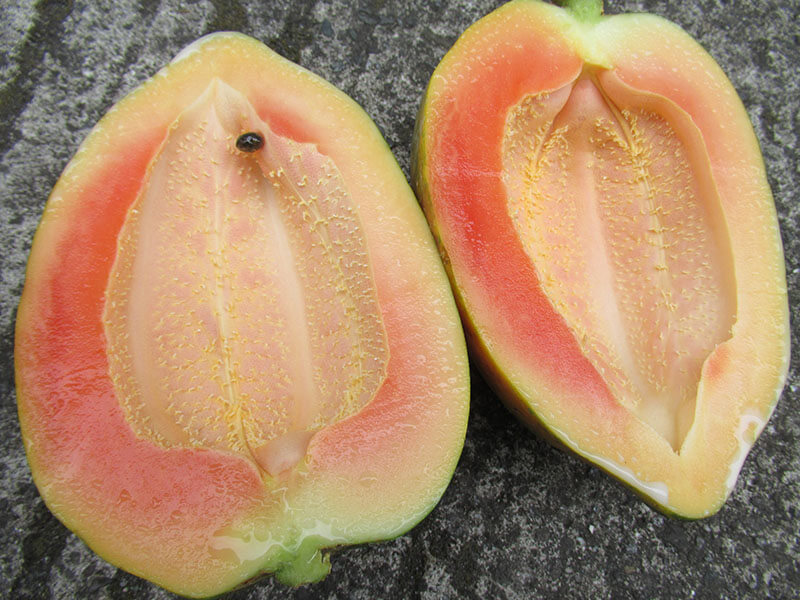
You can enjoy the papaya juice from papaya fruit.
Papaya has its origin in Mexico and Central America. The fruit was introduced to the Philippines in the mid-16th century. It also has some alternative names, such as papaw or pawpaw.
Papaya is divided into three sex categories while growing: female, male, and intersex. There are many variations of the fruit in the Philippines, including Cavite Special, Sunrise Solo, or Waimanalo. Cavite Special’s is around 3-5 kilograms and usually consumed raw.
Next, Sunrise Solo is regarded as one of the most delicate papaya species in the Philippines. It weighs up to 0.5 kilograms and features reddish-orange meat inside. Like the previous one, Waimanalo is also high quality and has orange-yellow pulp.
Filipino locals often use immature papaya to make Atchara, a classic Filipino side dish containing pickled papaya. Besides, they also have Ensaladang papaya, a bowl of papaya salad. Furthermore, they also use green papaya for cooking Okoy (deep-fried fitters), Tinola (soup), or Lumpia (spring rolls).
Nutrients: Vitamin A, C, E, and fiber.
Season: March to July.
How to eat: Cut the fruit in half, scoop out the seeds, and then enjoy the flesh. Besides, you can also make Filipino delicacies from papaya.
10. Watermelon
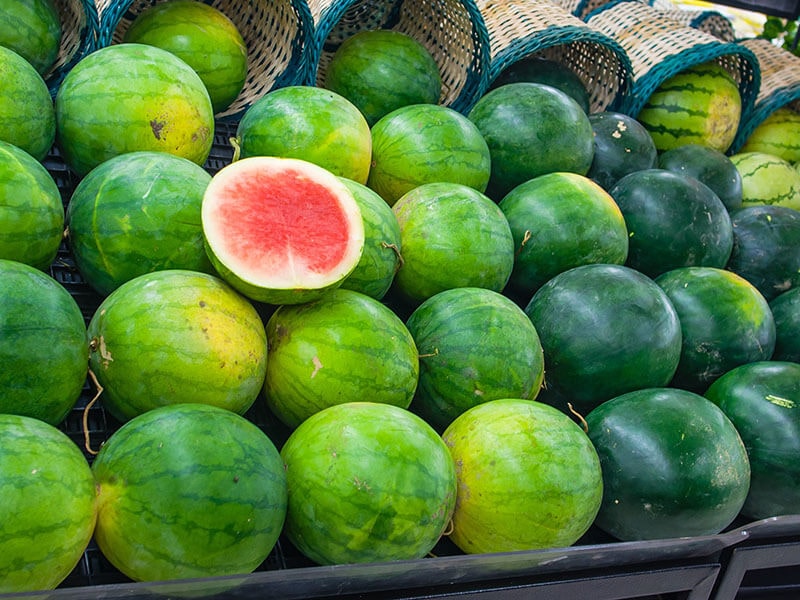
A tropical climate is an ideal place to grow watermelon, and the Philippines is no exception. This super common fruit belongs to the Cucurbitaceae family and has over 1000 species. In the Philippines, the common variants are Valencia, Meak, Klondyke, etc.
You can visit Bataan, Bulacan, or Pampanga to get some delicious watermelon in the country. Usually, wild watermelons tend to be 20 centimeters in width. However, when humans produce the fruit, it might grow up to 60 centimeters.
It’s a large round shape that is related to a football. The fruit has thick green skin with dark green stripes around the fruit. Depending on the type, watermelon will have different colors of meat, ranging from red, pink, and orange to yellow or white.
Because the fruit is very juicy and refreshing, I highly recommend you enjoy it in the summer. Take a bite, and you will love the slightly crisp consistency and the perfect sweetness.
Not only in the Philippines, but many countries also apply watermelon to make juice, smoothies, or salad. Besides, they also use the seeds to make melon seed powder. Sometimes, you will see this in many kinds of unlikely foods, like pickles.
Nutrients: Fiber, protein, vitamin A, C.
Season: March to July.
How to eat: You can cut the fruit into chunks or thick slices. Or you just cut it in half and use a spoon to consume it.
11. Durian
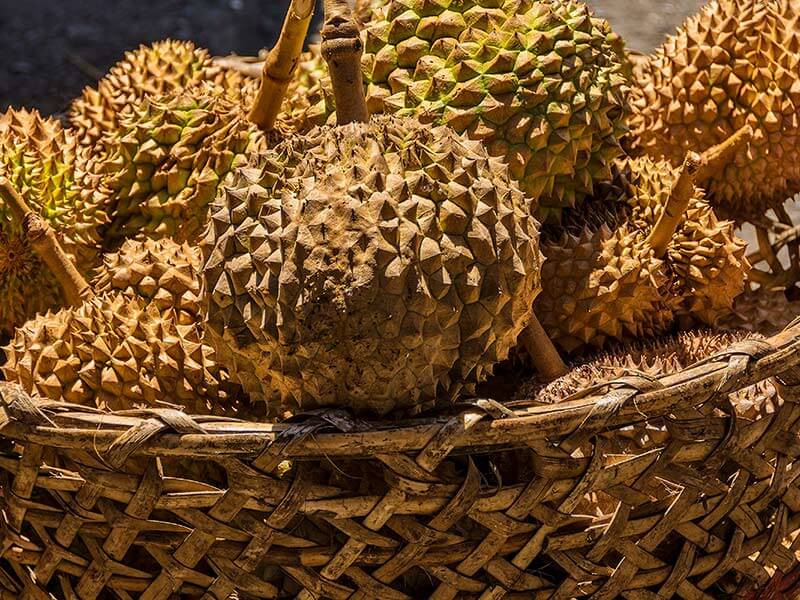
If you get bored with bananas or strawberries, try durians, the fruit of goodness. In the Philippines, you can purchase high-quality durian in Cotabato, Sulu, Agusan, and, most importantly, Davao, the so-called “durian capital” of the country.
Durian has a hard, thorny shell covered with spines. The fruit is relatively sizable, sometimes reaching up to 30 centimeters in length, 15 centimeters in width, and 1-3 kilograms in weight.
Arancillo presents a combination of slightly bitter and intense durian flavor. The flesh is dense and thick with a silky consistency. Meanwhile, Puyat is one of the big-sized durians with a beautiful yellowish-orange inner pulp.
For some people, durian smells like rotten onions. But many Filipinos think it’s an aromatic and remarkably delicious specialty.
Durian delivers a unique combination of sweetness, slight bitterness (depending on each type), and creaminess. Filipino locals usually apply this fruit to make delicious desserts.
Nutrients: Vitamin C, fiber, protein, manganese.
Season: August to November.
How to eat: Remove the skin and eat the pods inside.
7 Filipino Fruits In Yellow To Die For
These fruits in yellow can’t disappoint you! Prepare to have a feast with these amazing tropical fruits below. And now, let’s get started with mango, the national fruit in the Philippines.
12. Mango
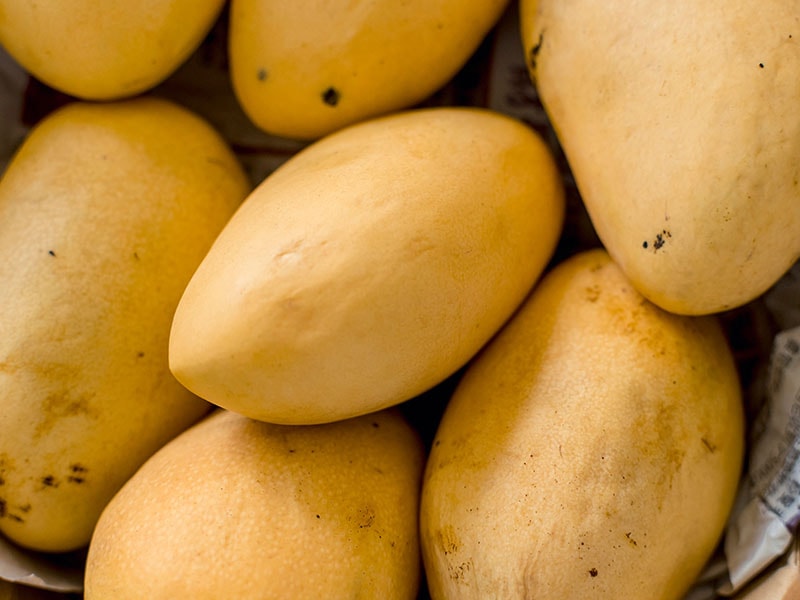
Mango is considered the national fruit in the Philippines, besides other fruits and vegetables in Pakistan and India. Although the fruit hails from Myanmar, Bangladesh, and India, it’s cultivated widely in other countries in Southeast Asia, especially the Philippines.
Mango variants are numerous. Each mango type will have differences in skin color, shape, or texture. There are several species of mango in the Philippines, such as Carabao and Pico (also known as Piko or Padero).
Carabao mango (Manila mango) is the most famous one. When reaching the mature stage, the fruit has greenish-yellow skin covering the juicy yellow meat inside. It is the sweetest mango variety according to the Guinness Book of World Records.
Pico mango is pale yellowish-orange and a bit flatter than Carabao. Contrary to most fruits, the Katchamita is highly recommended to enjoy when it’s still green and unripe. This mango is not as big as Carabao and tends to be round.
You can enjoy mango with any form of cooking, such as smoothies, ice cream, juices, salads, or milkshakes. Traditionally, Filipinos often serve green mangoes with Bagoong (a Filipino condiment).
Nutrients: Protein, fiber, vitamin C, A, E, copper, etc.
Season: March to June.
How to eat: Mangoes are better consumed raw. You can peel the skin by hand and cut the fruit into small pieces. You can also eat the meat and the skin after washing it carefully.
It is fun to learn more about the Filipino national fruit, mango.
13. Balimbing (Star Fruit)
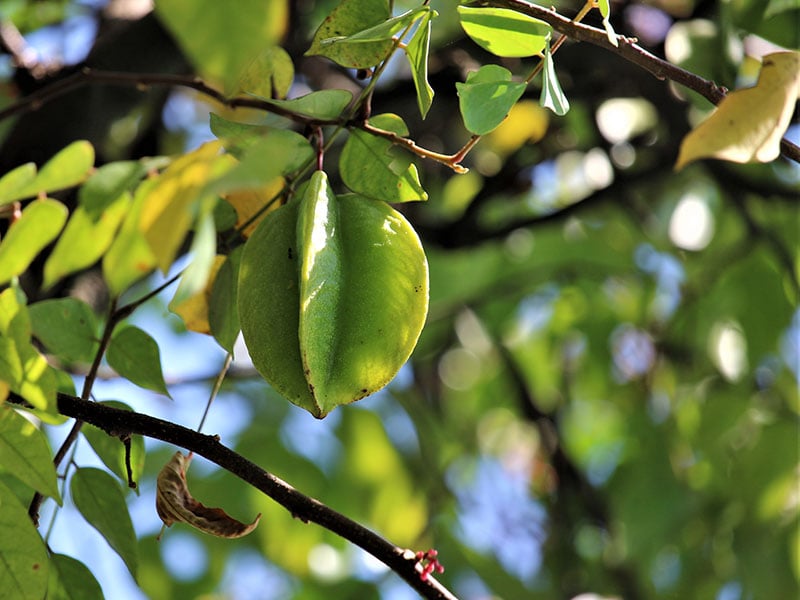
Filipino locals also have their star fruit, also known as Balimbing. Furthermore, the fruit is also one of the popular Malaysian fruits that goes by the name Carambola. Star fruit typically has two main categories: the smaller one with a tart taste and the sweeter, bigger type.
The star fruit has five to six ridges, which means each fruit will have up to 8-10 angles. Interestingly, Filipinos use the name “Balimbing” to call someone that is a traitor or has many faces.
The fruit has a waxy peel ranging from green, orange, to yellow, depending on how ripe it is. The flesh is transparent, varying from pale yellow to dark yellow. Every fruit contains around 10-12 tiny brown seeds.
Nutrients: Fiber, protein, vitamin C, B5, copper, potassium, etc.
Season: All-year round.
How to eat: Consume the whole fruit after washing.
14. Banana
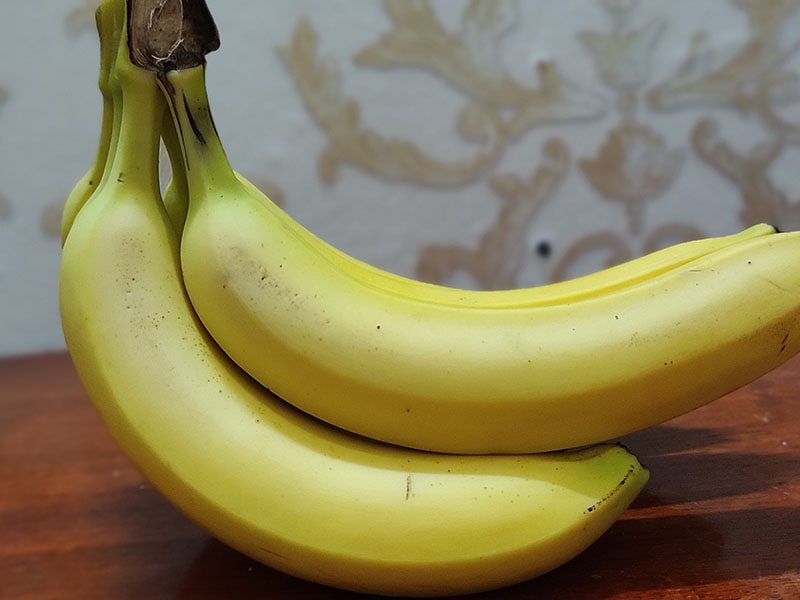
In the Southeast Asian country, most of the banana fruits are cultivated on Mindanao island. There are many banana varieties that you need to take a look at, such as Lakatan, Latundan, Saba, etc.
Lakatan is the most popular banana type, particularly in Manila. The fruit has a bright yellow color with some brown blush on it. When it reaches perfect maturity, the flesh will have a unique yellowish-orange color and contain a great deal of vitamin A.
Similarly, Latundan boasts a solid reputation in Manila. This type of banana has a thinner peel than the first one, covering the white flesh that presents the tangy tropical flavor.
The Saba variant is recognized as an essential ingredient in Filipino cuisine. From Pochero (stewed dish) to banana ketchup, these foods can not reach the perfect taste if Saba is missing.
Nutrients: Vitamin C, B6, antioxidants, protein, and fiber.
Season: September to December.
How to eat: You just need to peel the fruit from the stem and bite the flesh inside.
15. Longan
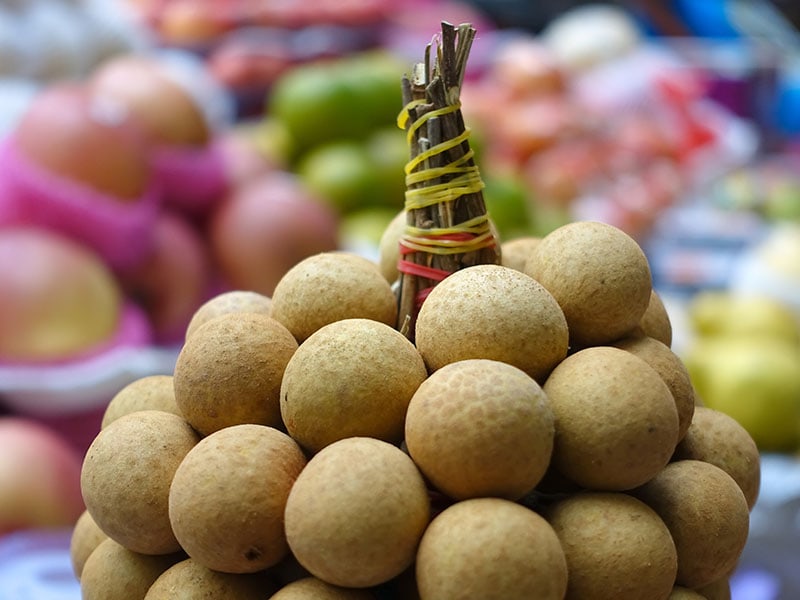
If you think longan only grows in China, you are making a big mistake! This fruit is a relative to the rambutan and lychee, meaning they have the same family: the Sapindaceae.
It is round with a width of 2-3 centimeters. Longan has thin and brittle skin with a fuzzy feeling. Its color ranges from green and light brown to yellowish-brown and brown.
According to the Cantonese language, longan refers to “dragon eyes”, which also indicates the image of the fruit: the delicate meat surrounding the black seed, making the fruit look precisely like an eye.
The inner flesh is firm and a bit crunchy with a slightly juicy texture. The fruit brings a natural sweetness with a hint of tropical and floral flavor.
Nutrients: Vitamin C, potassium, protein, fiber.
Season: March to May.
How to eat: You can crack the shell with your snails, suck the flesh, and discard the seed afterward.
16. Santol
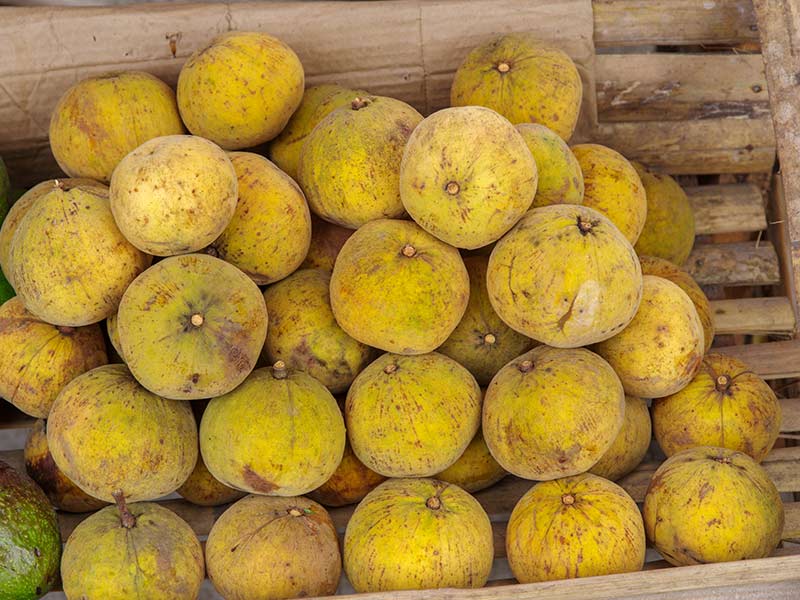
You can call santol by different names, including Sandoricum koetjape, santol, cotton fruit, or sentul. This fruit originated in Southeast Asia and has gradually gained popularity in other places.
Santol has two main variations: yellow and red. For some reason, the red type might grab more attention than the yellow one.
Interestingly, the look on the outside of santol is almost the same as the peach, from shape and size to the tiny fuzzy hair on the skin. But its inside may look a bit like mangosteen with 4-6 segments.
Depending on different varieties, the skin can be rather thick or thin. In some types of santol, you can freely use a spoon to enjoy both the pulp and the outer rind. The small, brown seeds are inedible and have to be spitted out.
Santol presents a unique sour-sweet flavor with a combination of mild peach and apple. Locals also use santol to give the dish a naturally sweet-sour taste, including Sinigang (Filipino sour soup).
Nutrients: Iron, vitamin C, calcium, and phosphorus.
Season: July to September.
How to eat: You cut the fruit enough to open the skin, then enjoy the flesh inside. Regarding Filipino cuisine, santol can be used to make Sinantolan (grated santol fruit with other ingredients).
17. Pineapple
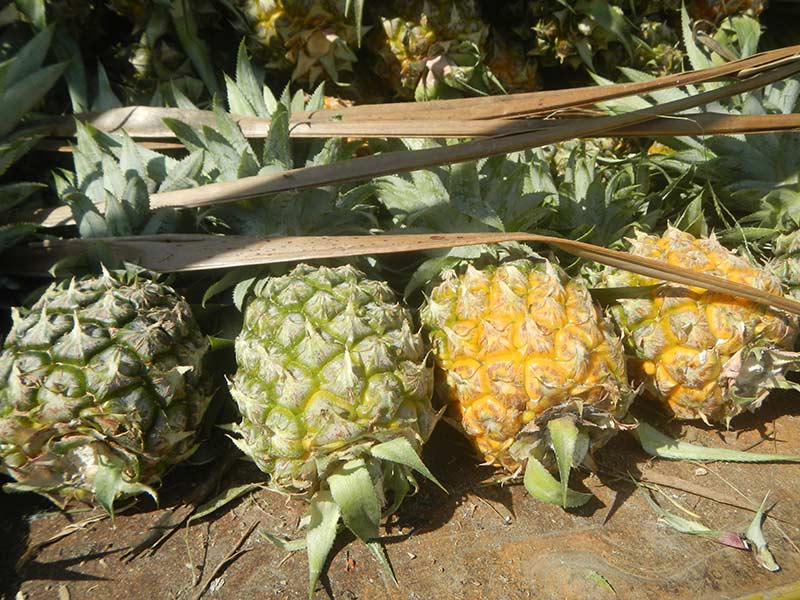
Pineapple originated from Brazil and Paraguay. It followed the Spanish and Portuguese to Southeast Asia, especially the Philippines. Now, the Philippines is one of the top countries that grow and export pineapples.
There are three main pineapples in the Philippines: Formosa (Queen), Smooth Cayenne, and Red Spanish (Native Philippines Red). The Smooth Cayenne has a pale yellow flesh with a tender and juicy texture, delivering a sweet-sour taste.
If you want to tell which one is Smooth Cayenne, just observe whether it has golden eyes on top of the spiny shell. This type is also almost the heaviest, around 2.5-3 kilograms.
On the other hand, the Formosa one has a size of around 0.5-1 kilogram with green skin and yellow eyes. This variant is sweeter and crisper than Smooth Cayenne.
Meanwhile, the Red Spanish is 1-2 kilograms in weight and is primarily produced in Western Visayas. In terms of color, it usually is reddish-brown or yellowish-orange.
In Filipino cuisines, you will see a bunch of popular dishes using pineapples, such as Hamonado (meat dish) or Afritada (braised dish). Also, there is an iconic dessert from the Philippines containing pineapple, Nata de Pina (pineapple gel).
Nutrients: Protein, vitamin C, B6, copper, fiber, potassium.
Season: All year-round, but the peak pineapple season in the Philippines is April-July.
How to eat: Use a knife to get rid of the shell, then it’s up to you to cut it into slices or whatever shapes you want.
18. Lanzones
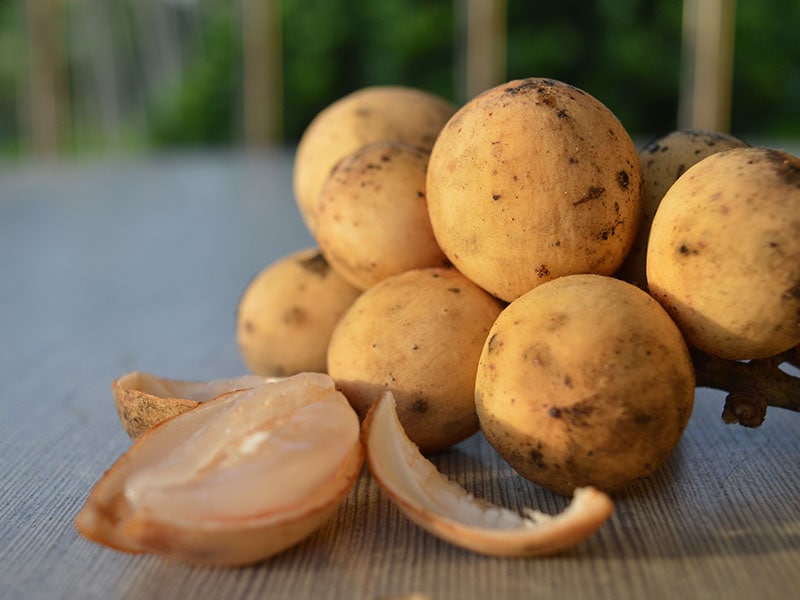
People find lanzones not only in Malaysia and Indonesia but also throughout the Philippines, particularly in the country’s southern islands, like Laguna, Batangas, and Quezon.
Lanzones trees often reach an average height of 10.5-15 meters. Lanzones fruit is oval, around 2-7 centimeters in diameter. The fruit has thick skin with a yellow to yellowish-brown color, covered with tiny yellow hair, giving the fruit a fuzzy touch.
The pulp inside will have 4-5 transparent segments. The fruit is divided into two notable species: duku and langsat.
Regarding the size, duku is larger than langsat. When cooked, the latter will release the sap from the fruit, while the former won’t. The taste of the fruit changes from sour to sweet as it ripens.
Nutrients: Fiber, vitamin C, B, A, calcium, phosphorus, and iron.
Season: August to December in Mindanao.
How to eat: You can peel its skin or crack it open with your teeth or a knife. Then you can pull the flesh into your mouth. There are many cooking techniques with lanzones.
How About Some Red Filipino Fruits To Brighten Up Your Day?
Red is a gorgeous and beautiful color, and the fruits below are the same. Each fruit will have its unique aspect, surely keeping you munching on them daily. Let’s keep reading to receive astonishing results!
19. Pitaya (Dragon Fruit)
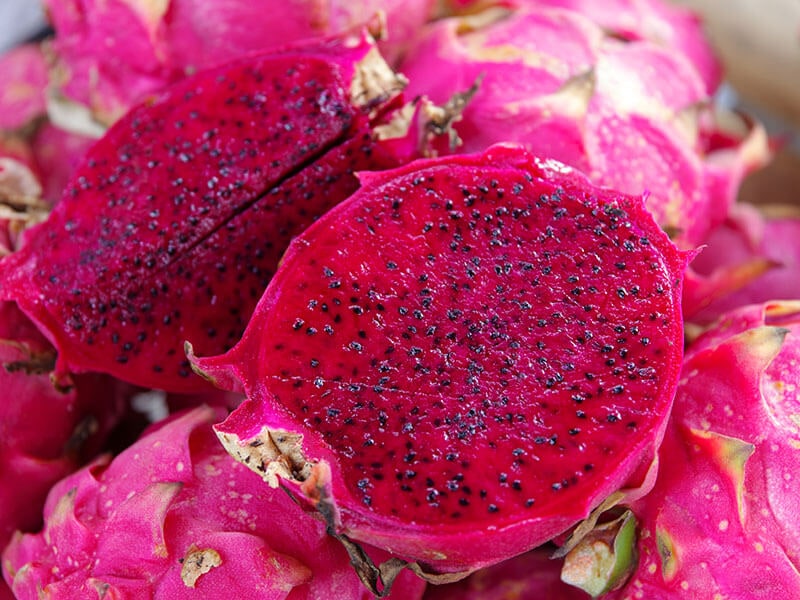
In the Philippines, you can find the fruit in almost every province, typically in Cavite, Ilocos, Davao to Pangasinan, Nueva Ecija, or Quezon. The fruit is bountiful in the local markets and is one of the reasons that attract visitors to the Philippines.
Because of the appearance of the dragon-like skin, pitaya also has another famous name, dragon fruit. But you might come across many other terms, like a green dragon, dragon crystal, or strawberry pear.
There are two famous pitaya types in the Philippines: pitaya Blanca and pitaya Roja. Besides, there is pitaya Amarilla, but this fruit with yellow rind is less common. The first variant has white flesh inside and pink skin outside, while the red-fleshed pitaya Roja is smaller yet sweeter.
Nutrients: Protein, fiber, vitamin C, iron, magnesium.
Season: April to November.
How to eat: The easiest way to enjoy pitaya fruit is to use a knife to cut it in half and scoop the flesh out with a spoon.
Find out what it is to go on a trip around a Filipino dragon fruit farm here!
20. Siniguelas (Red Mombin)

Depending on each region this fruit grows, the name will change correspondingly, such as red mombin, Spanish plum, Siriguela, or Siniguelas in the Philippines.
Siniguelas is native to Mexico and Brazil. After being brought to the Philippines in the 16th century, it gradually grew in popularity.
The fruit is about 2.5-5 centimeters wide and nearly has an oval shape. Depending on the variant and maturity stage, the skin color will range from green, yellow, to red or purple.
The flesh inside will gradually turn yellow when the fruit reaches its ripest. Remember to get rid of the edible stone while enjoying the fruit. People often describe the flavor as sweetness with a tinge of sourness.
Although Siniguelas is just a tiny plum, it contains many health benefits. The fruit provides you with antioxidants, vitamins, and especially fiber. Besides, locals usually pick unripe ones to make pickles or tart sauce.
Nutrients: Vitamin A, B, C, calcium, iron, etc.
Season: In the summer.
How to eat: You just need to wash the fruit carefully and then consume the fruit without the seeds. Besides, you can apply Siniguelas to make juice, jelly, jam, or wine.
21. Makopa (Wax Apple)
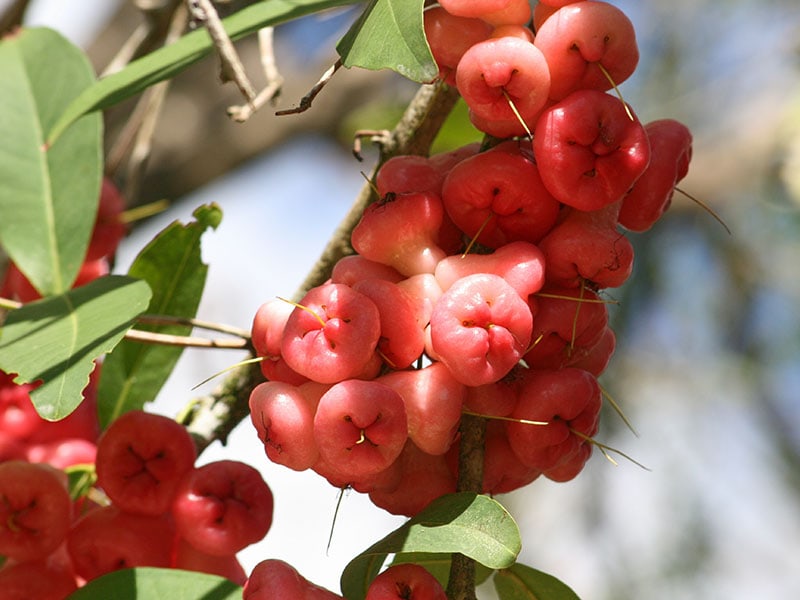
Wax apple, Java apple, rose apple, or Makopa, you can use any of these names to call the fruit. It’s cultivated in the Philippines, India, Indonesia, and Malaysia.
The reason why the fruit is called wax apple is that it has waxy and smooth skin. The red skin also makes the fruit look like an apple, hence the name.
Depending on many conditions, it may take on many hues: bright red, light pink, greenish-white, or white. Wax apples have a pear shape between 4 and 6 centimeters long. The inner meat is crunchy and spongy, with 1-2 seeds.
Some people say wax apple texture is similar to that of watermelon. If possible, try Black Pearl (Black Diamond), which is a variant with black skin, one of the most expensive types.
Nutrients: Vitamin C, iron, calcium, potassium, magnesium, energy.
Season: In the dry season.
How to eat: Normally, you just need to wash the fruit thoroughly and then enjoy the whole fruit without seeds. Or you can cut it into each segment and remove the core. Besides, people also use it to make a salad.
22. Rambutan

Rambutan is one of the famous fruits that originated in Southeast Asia. This fruit hailed from Southeast Asia and is a relative of other tropical fruits such as lychee, pulasan, or longan. It finally appeared in the Philippines in 1912, thanks to Indonesians.
The fruit has a round or oval shape measuring between 3-6 centimeters. But in some rare cases, it might grow up to 8 centimeters.
Depending on the maturity stage and variants, rambutan skin can have anything, like red, orange, yellow, or a mixture of these colors. The remarkable thing about this tropical fruit is that it has bendy spikes that make it look like a hairy ball.
Under the skin is the translucent flesh covering one light brown seed. The meat can be pale pink or white and present an excellent combination of sweetness and sourness, plus the distinct floral scent.
In the Philippines, people tell apart the two most famous variants by observing the seed. Typical rambutan is one whose seed is hard to split from the flesh. Meanwhile, the Maharlika rambutan is easier for you to do so.
Nutrients: Vitamin C, fiber, minerals, copper.
Season: August to October.
How to eat: You make a small incision that is enough to split the shell in half. Then eat the flesh and remove the seed.
23. Aratilis (Kerson Fruit)
Come to the Philippines, and you will see Aratilis or Kerson fruit grow bountifully in any Filipino household’s garden. You might never have heard of the fruit before, but this fruit is part of every Filipino childhood.
The Aratilis tree usually rises from 7 to 12 meters and occasionally produces fruit during the summer. Green Aratilis fruit has an unpleasant flavor. So you must wait for it to ripen to enjoy its sweet, soft, and juicy taste. This fruit is considered a handy snack for adults and children.
Although Kerson fruit is just a little tiny red berry, it provides your health plenty of benefits, namely, decreasing inflammation or relieving pain.
Nutrients: Protein, fiber, water, calcium, etc.
Season: In the summer.
How to eat: You can eat the fruit straight from the tree, but I recommend washing it first. Besides, this fruit can also become an excellent glass of juice or salad.
Other Delicious Fruits In The Philippines That You Need To Taste
Although I put these fruits at the end of the list, that doesn’t mean I underestimate the delicious and health benefits it brings to humanity.
24. Tamarind
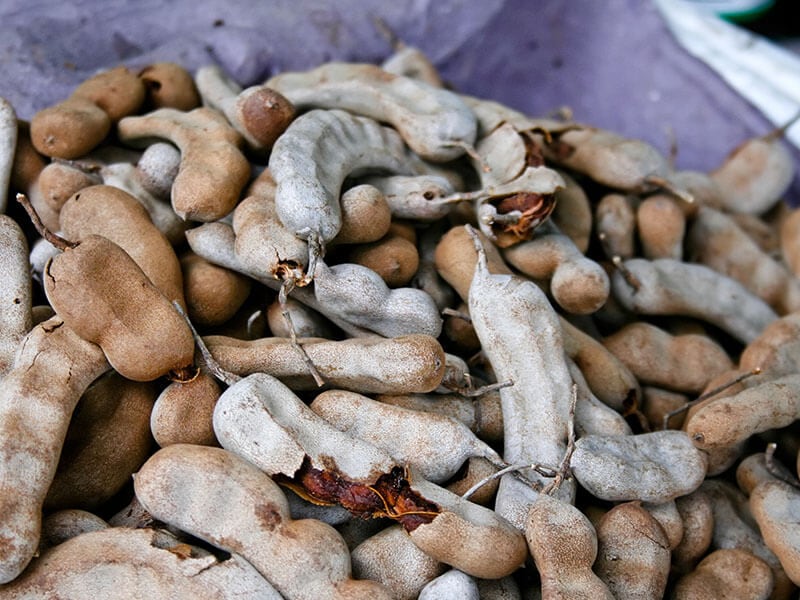
If you love the sourness of the famous Sinigang from the Philippines, you need to know about the secret element of the recipe: tamarind. This acidic fruit has traditionally been produced in many Asian countries, including the Philippines, Indonesia, and India.
This fruit is a member of the Fabaceae family from tropical Africa. In the Filipino language, people call tamarind by some names, such as Sampalok, Sampaloc, or Sambag.
The fruit delivers a sweet-sour taste that usually appears in pods like peas. A typical pod in Asia contains 6-12 seeds, while in Africa and West India, the pods only have 1-6 seeds.
When matured, the skin is brown with a hard and brittle texture. It envelops the soft reddish-brown flesh, an essential component in most Southeast Asia cuisines.
Nutrients: Vitamin C, fiber, protein, etc.
Season: August to October.
How to eat: Use your fingers to curve the pod and crack it open, discard the strings running along the fruit, and enjoy the flesh without seeds. Filipinos often utilize fruit in cooking, like Sinigang soup.
If tamarind fruit still sounds strange to you, then this one is perfect.
25. Mangosteen

This tropical fruit has been around in the Philippines for a long time. If you want to eat the most qualified mangosteen in the country, you can come to Luzon and Mindanao islands.
This fruit is considered the “Queen of Fruits” because of its image, and it also pairs well with durian, the “King of Fruit”. The fruit features the size of a small tangerine and has a stem that looks like a crown on top.
Depending on the maturity, the thick skin will range from green and red to purple in color. The fruit usually has 4-9 white segments covering the brown seeds.
The flesh is super juicy with some fibrous consistency. Its sweet and tangy taste, plus the floral and fruity smell, contributes significantly to mangosteen’s reputation.
Nutrients: Fiber, vitamin C, B9, B1, manganese, copper, and magnesium.
Season: March to June.
How to eat: Use a knife to leave a cut enough to crack the fruit open.
26. Chico (Sapodilla)

Chico or sapodilla also goes by the names of sapote, naseberry, or chicle. It stemmed from southern Mexico, America, and the Caribbean. The fruit was first brought to the Philippines early in the Spanish colonial period.
The tree’s average height is often between 9-15 meters, but in some exceptional cases, the tree can grow up to 30 meters. The chico fruit might have a similar appearance to the kiwi fruit, though sweeter in taste and softer in texture.
There are three famous types of Chico in the Philippines: Pineras, Ponderosa, and Sawo Manila. The first type has a medium size and a round to elliptical shape. It features a firm touch intermixing with a grainy and dry (sometimes juicy) texture.
The second variety is the largest one, usually weighing up to 350g. By contrast, the last one looks like kiwi fruit the most and presents the brown-sugar cinnamon flavor.
With Chico, you can make many foods, including jams, syrups, or muffins. The fruit has a naturally sweet flavor, so you don’t need to use sugar to sweeten the dessert.
Nutrients: Rich in fiber, vitamin C, and copper.
Season: January and February.
How to eat: The easiest way to eat sapodilla is you cut the fruit in half and then use a spoon to scrape the brown flesh out of it.
If you want to learn more about the way Filipinos collect chico, here it is!
What Do You Have In Mind About Fruits In The Philippines?
The Philippines is ideal for growing many tropical fruits that make your mouth water on ends. I have already provided you with at least one fruit to enjoy from spring to winter. Some fruits you can find easily in the supermarket, but some will require you to come to the country.
In case you find my post interesting and helpful, give it a like and share around with the people who need this information. Also, if you know other popular fruits in the Philippines, feel free to leave a comment below.


Linda Dean
Expertise
Culinary Arts, Food Journalism, Global Cuisine, Exploration, Recipe Development, Cultural Food Studies, Culinary Travel and Storytelling
Education
Culinary Institute of America, Hyde Park, NY
Program: Associate in Culinary Arts
Focus: Developed a comprehensive understanding of global cuisines and essential cooking techniques. Engaged in intensive hands-on practice in both kitchens and real-world settings, guided by expert chefs. This program emphasized the application of culinary skills in professional environments, preparing students for a variety of roles in the culinary industry.
City, University of London, London, UK
Program: BA Journalism
Focus: Gained expertise in media studies with a strong foundation in reporting, editing, and communicating. While the program focuses broadly on journalism, the skills acquired apply to food journalism, including the ability to analyze and report on food culture and culinary trends effectively.
Linda Dean is an experienced chef and food writer who loves exploring flavors from around the world. Trained at the Culinary Institute of America, Linda has spent over ten years mastering the art of making dishes that truly represent different cultures. She also studied journalism at City, University of London, which helps her write engaging stories about these foods.
On heythattastesgood.com, Linda shares recipes that bring the world’s kitchens to her readers. She focuses on authentic tastes and the stories behind them, making it easy for anyone to try international cuisine at home.